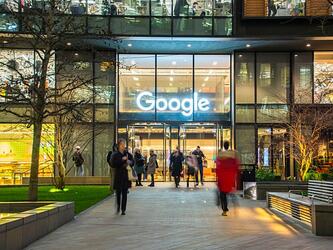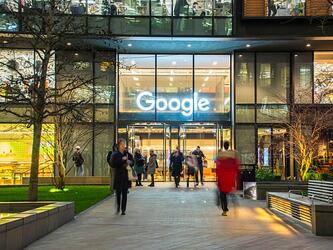The dawn of a new G
In 2006, you could smoke in a restaurant in England and BlackBerry dominated the smartphone market. How times have changed.
Think back to how you got somewhere you hadn’t been before – I was a big fan of the printed-out Google map. Then, in 2007, the iPhone launched and triggered a societal shift. Yet consumers didn’t immediately default to the new technology that shapes our lives today.
In my opinion, 5G – and the impact it can have on augmented reality (AR) and virtual reality (VR) – represents a new societal trigger. There is huge potential for AR and VR to be used as an extension of brand experience.
According to a recent Gartner study, 100m consumers will shop via AR and VR – whether instore or online – by 2020. At Kinetic, we have collaborated with Marks & Spencer to produce pop-up VR showrooms where consumers can create their ideal living space. Chinese e-commerce company Alibaba has also launched a complete VR shopping experience. 5G mobile network technology represents an opportunity to accelerate the adoption of VR and AR.
There is huge scope for researchers to demonstrate value to a business by identifying not only when their target audience will adopt a new technology, but also understand which technological features will benefit customers most, resulting in changing consumer behaviour.
There are three rules to adhere to when advising brands how and when to embrace new technology.
Timing
Brands have the potential to do some great mixed-reality communications – but just because we can, doesn’t mean we should. It’s important to think about who will use such communication; do consumers have the technology to do this?
A key reason AR and VR have not been widely adopted is because they need to access and manage huge amounts of data. With ultra-high speed, ultra-low latency and high bandwidth, 5G can support real-time rendering for immersive video, and shorter download and set-up times.
Vodafone will launch 5G in the UK in July, bringing with it the potential for more VR and AR brand experience.
However, this doesn’t mean that, overnight, everyone will be 5G enabled. Launching a product or brand communications too early could lead to failure, with too few people able to use it. We are looking at the take-up of 4G to understand when early adopters and the early majority will have the technology, so we can advise clients accordingly.
This is just part of the puzzle, however; consumers need to feel comfortable using the technology and this is to do with societal, as well as individual, attitudes. In the UK, QR codes as part of out-of-home communications flopped for many reasons, not least because initial experiences were often poor and people felt uncomfortable interacting with the technology in a public sphere. Walking up to a poster and holding their phone to it made people feel awkward – although, in China, QR codes have flourished and this behaviour is now the norm.
Adept market research can be used to predict the right time to enter the market. Using predictive techniques such as asking how people in your area will do things, rather than what the individual will do, has been shown to be a better way of predicting elections, and we are embracing this theory for technology use.
Emphasis
What should the business focus on? What is the key benefit to the consumer? What if 5G offers 10GB/s and has ultra-low latency – who cares if this means the realisation of the Internet of Things and mixed reality? Translating technology speak into consumer benefits is key.
Asking consumers what they want from a technology of which they don’t have experience rarely yields good insight. Great researchers can use different techniques, however – such as laddering – to understand what the benefits are that consumers want.
Henry Ford may have said “if I had asked people what they wanted, they would have said faster horses” – but the main benefit they wanted was something that got them from A to B quickly. The key finding is that consumers want something to get them to places quicker. The key insight for business is develop a product that delivers speed and communicate that your new product (the car) is faster than a horse.
Jeff Bezos, founder of Amazon, recently said: “No customer was asking for Echo. Market research doesn’t help. If you had gone to a customer in 2013 and said: ‘Would you like a black, always-on cylinder in your kitchen – about the size of a Pringles can – that you can talk to and ask questions of, and that also turns on your lights and plays music?’, I guarantee they’d have said: ‘No, thank you’.”
Consumers might not want a black Pringles box that plays music, but they might want to order their shopping, hands-free, in the kitchen.
Don’t build up your part
People don’t love brands. People love their cats, not their cat-food brand. Successful brands make people’s lives easier. People who buy from Amazon and Ford don’t love them, but these brands do make people’s lives easier.
In understanding how to change human behaviour, I often reference BJ Fogg’s behaviour model. Core to the model is the equation B=MAT, whereby behaviour change needs three things: motivation (I want to use the AR technology) ability (I have a 5G phone) and a trigger (I saw a poster advertising this). When these three things come together, you get behaviour change – and effective research can help to uncover this.
Sometimes, communication messages don’t work because the motivation isn’t there, as brands have assumed they are loved. Thinking about all the potential that VR and AR have to offer consumers, and putting this into the context of the Fogg Behaviour Model, can benefit brands.
It’s all about picking a topic that resonates with the audience, and identifying an audience to which that communication appeals. This is where great advertising can help. Advertising – and great market research – is not about being efficient (in the short term), but more about being effective in the long-term development and success of the business.
Jennie Roper is head of insight at Kinetic

We hope you enjoyed this article.
Research Live is published by MRS.
The Market Research Society (MRS) exists to promote and protect the research sector, showcasing how research delivers impact for businesses and government.
Members of MRS enjoy many benefits including tailoured policy guidance, discounts on training and conferences, and access to member-only content.
For example, there's an archive of winning case studies from over a decade of MRS Awards.
Find out more about the benefits of joining MRS here.













0 Comments